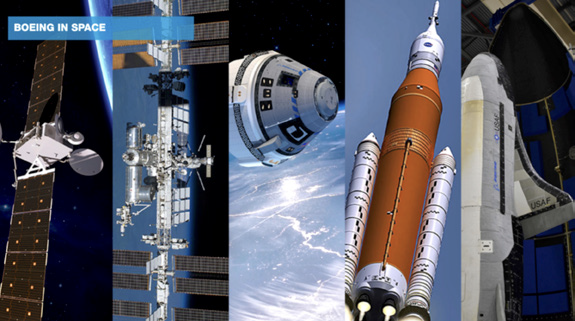Network Innovations U.S. Government announces joint multi-orbit RF sensing deployment with INTEGRASYS + AvL Technologies
Network Innovations U.S. Government (NIUSG), a subsidiary of Network Innovations, has announced that the company has completed the deployment of a Multi-Orbit RF Sensing platform in partnership with INTEGRASYS and AvL Technologies.
 This supports ongoing collaboration with the three companies in Space Domain Awareness (SDA) and SATCOM Situational Awareness (SATCOM SA) as a Service efforts. This platform will deliver processed data at the tactical edge to customized customer endpoints, including the Global Data Marketplace.
This supports ongoing collaboration with the three companies in Space Domain Awareness (SDA) and SATCOM Situational Awareness (SATCOM SA) as a Service efforts. This platform will deliver processed data at the tactical edge to customized customer endpoints, including the Global Data Marketplace.
The turnkey data-service capabilities in this prototype contract align with the end user’s preferred aggregation, analysis, and distribution system and support the desired data rights to be relevant in modern conflicts and joint operations.
At the core of this deployment is Controlsat, INTEGRASYS’ advanced Carrier Under Carrier monitoring system, integrated by Network Innovations to enable real-time RF sensing in complex multi-orbit environments. Controlsat detects, analyzes, and visualizes overlapping carriers without interrupting service—ensuring continuous signal awareness, interference detection, and mission resilience. Its precision is critical for high-demand government operations where performance and reliability are non-negotiable.
Mike Felix, Vice President, Advanced Programs for Network Innovations U.S. Government, said, “NIUSG is excited to continue our demonstrated success of bringing new capabilities and value to our customers through novel prototypes on aggressive timelines. We will leverage our strengths in software development, systems integration, and Ground-Station-as-a-Service (GSaaS) to expand our customers’ capabilities in radio frequency sensing. By leveraging award-winning capabilities from our partners INTEGRASYS and AvL Technologies, we will provide new AI-driven SATCOM and signals monitoring, interference detection, and geolocation capabilities to our key stakeholders. This also pushes forward our joint efforts to modernize and more tightly integrate intelligent Electronic Warfare solutions.”
 Paul Sandoval, Vice President of Sales-Americas, at INTEGRASYS, said, “We’re proud to partner with NIUSG to deliver an advanced, AI-assisted RF Spectrum Awareness system powered by our innovative software portfolio.” At the heart of this innovation is INTEGRASYS’ AI4RF – a core technology enabling real-time sensing and transmission of RF spectrum data, including signal classification, EMI interference detection, and geolocation. Leveraging geographically distributed RF sensors and taskable multi-orbit, multi-frequency AvL Technologies X/Y antennas, the system provides precision data exactly where and when it’s needed.”
Paul Sandoval, Vice President of Sales-Americas, at INTEGRASYS, said, “We’re proud to partner with NIUSG to deliver an advanced, AI-assisted RF Spectrum Awareness system powered by our innovative software portfolio.” At the heart of this innovation is INTEGRASYS’ AI4RF – a core technology enabling real-time sensing and transmission of RF spectrum data, including signal classification, EMI interference detection, and geolocation. Leveraging geographically distributed RF sensors and taskable multi-orbit, multi-frequency AvL Technologies X/Y antennas, the system provides precision data exactly where and when it’s needed.”
Dave Provencher, Vice President of Business Development for AvL Technologies, said, “AvL Technologies is honored to have been selected by Network Innovations U.S. Government (NUISG) for this prestigious program. Our field-proven 2.4mXY terminal was chosen for its full hemispherical tracking capability and its ability to operate in X, Ku, and Ka bands with rapid changeover, making it a truly multi-orbit multi-band solution.”
Modernized GPS operating system closer to operational integration
The U.S. Space Force’s Space Operations Command has accepted a modernized operating system for Global Positioning System (GPS), which is designed to maintain resiliency of the constellation and improve positioning, navigation and timing services to meet user demand now and in the future.
 The GPS Next Generation Operational Control System upgrade is one of several current Space Systems Command acquisition programs, which, in aggregate, will deliver numerous modernized GPS III enterprise capabilities. The other programs include the GPS III/IIIF satellite vehicles and Military GPS User Equipment.
The GPS Next Generation Operational Control System upgrade is one of several current Space Systems Command acquisition programs, which, in aggregate, will deliver numerous modernized GPS III enterprise capabilities. The other programs include the GPS III/IIIF satellite vehicles and Military GPS User Equipment.
These modernized enhancements will enable improved signal access in electronically impeded environments; improved ability to detect failures; improved position and time transfer accuracy; and improved capability ensuring integrity and uninterrupted availability of the military code.
The Guardians in Mission Delta 31 partnered with SSC to develop a methodical process of transition exercises, transition rehearsals and constellation transfer trials to ensure the integrity and capability of the system prior to complete transfer, explained U.S. Space Force Col. Stephen Hobbs, MD 31 commander. “Additionally, there are risk reduction activities designed to demonstrate OCX’s ability to integrate using residual, on-orbit GPS satellites.”
OCX delivery was initiated by contractor Raytheon to the U.S. Government via the submission of the Department of Defense Form 250 on July 1, 2025. Upon acceptance of the system, MD 31 will continue integrated systems testing, Operational Readiness Exercises and preparation activities for the GPS constellation transfer.
One of our missions is to deliver sustained, reliable GPS capabilities to America’s warfighters, our allies and civilian users. The current enterprise modernization efforts underway gives users confidence that GPS will continue to provide worldwide premier PNT service,” said Cordell DeLaPena, Space Systems Command program executive officer for Military Communications and Positioning, Navigation and Timing.
Redwire announces addition of the Edge Autonomy Stalker UAS to the DoD’s Blue List of approved drones
Redwire Corporation (NYSE: RDW) has announced that the Stalker uncrewed aerial system (UAS), developed by Redwire’s wholly owned subsidiary, Edge Autonomy, has been granted an Authority to Operate (ATO) and is now on the Defense Innovation Unit (DIU) Blue UAS list.
 The DIU Blue List contains technology vetted and approved by the Department of Defense (DoD) authority for universal use across government agencies. Drones on the DIU Blue List are subject to rigorous testing to ensure they meet stringent cybersecurity, NDAA-compliance, and operational requirements. This process ensures that the necessary technology is in place to maintain and promote national security while addressing operational challenges at speed and scale.
The DIU Blue List contains technology vetted and approved by the Department of Defense (DoD) authority for universal use across government agencies. Drones on the DIU Blue List are subject to rigorous testing to ensure they meet stringent cybersecurity, NDAA-compliance, and operational requirements. This process ensures that the necessary technology is in place to maintain and promote national security while addressing operational challenges at speed and scale.
Edge Autonomy, a wholly owned subsidiary of Redwire, specializes in delivering innovative autonomous systems, advanced optics, and resilient energy solutions that are being used by the DoD, U.S. Federal Civilian Agencies, and allied governments. With nearly four decades of technology heritage and manufacturing expertise, Edge Autonomy’s experienced team delivers proven solutions based on real-world mission needs.
With nearly two decades of flight operations around the world, the Stalker UAS is a secure, battle-proven solution for ISR missions in all environments. The addition of the Stalker UAS to the DIU Blue list will enable more government agencies and operational units to gain access to this cutting-edge system
The Blue List selection is an important recognition that streamlines Redwire’s ability to deliver combat-proven, commercially developed UAS technology at scale to meet the Department of Defense’s evolving mission needs,” said|
Peter Cannito, Chairman and CEO of Redwire. “As the White House looks to advance the domestic commercialization of UAS technologies at scale and ramp up domestic production, Redwire is positioned at the forefront of strengthening our nation’s drone industrial base and delivering unmatched capabilities to the U.S. warfighter.”
York Space Systems’ parent company to acquire ATLAS Space Operations
York Space Systems has agreed to acquire ATLAS Space Operations—this move brings York a powerful, software- led, ground architecture that simplifies operations, removes integration barriers, and enhances space-to- ground resilience—accelerating York’s ability to deliver secure, mission-ready space systems at unmatched speed and value.

The DIU Blue List contains technology vetted and approved by the Department of Defense (DoD) authority for universal use across government agencies.
Drones on the DIU Blue List are subject to rigorous testing to ensure they meet stringent cybersecurity, NDAA-compliance, and operational requirements.
This process ensures that the necessary technology is in place to maintain and promote national security while addressing operational challenges at speed and scale.
ATLAS will play a key role in York’s Golden Dome architecture, a next-generation defense solution that unifies spacecraft, software, and ground operations to deliver full-spectrum capabilities across contested environments.
ATLAS will continue to operate independently under its existing brand, serving its diverse portfolio of customers across the space industry.
Founded in 2015, ATLAS delivers secure, cloud-native connectivity through its Freedom® Ground Software as a Service (GSaaS) platform, which provides a single API access point to a global network of more than 50 antennas in 20+ countries and is the only GSaaS provider based in the United States.
By shifting the complexity of satellite communications from hardware to software, ATLAS has built a federated network-of-networks that enables real-time tasking, automated scheduling, and seamless cloud delivery of mission data.
The result is a flexible, scalable solution that reduces cost, risk, and time to orbit for a growing roster of government and commercial customers.
The Freedom® platform simplifies ground operations through a single API that abstracts away the complexities of legacy ground station networks.
Whether operating a single satellite or a proliferated constellation, customers can onboard faster, stream data directly to the cloud, and flexibly access global infrastructure without building it themselves.
This acquisition will strengthen York’s ability to deliver integrated, mission-ready systems by pairing its high-performance spacecraft and software-defined operations with ATLAS’s proven ground communications platform, thereby enhancing end-to-end mission delivery, and accelerating deployment timelines, improving data flow from space to ground, and enabling more resilient, autonomous operations across both commercial and national security missions.
The acquisition of ATLAS is pending FCC approval and other customary closing conditions.
“ATLAS has built one of the most sophisticated and secure ground communications platforms in the industry,” said Dirk Wallinger, CEO of York. “This acquisition will enhance York’s ability to deliver mission-ready systems on the timelines our customers demand while continuing to support the broader space ecosystem with best-in- class ground solutions.”
York shares our vision for a future where space systems are faster, smarter, and seamlessly integrated,” said Corey Geer, CEO of ATLAS. “Together, we are building the infrastructure to meet that future head-on, reducing risk, increasing resilience, and enabling critical data delivery on demand.”
Dawn Aerospace joins the 10 million euros LEO2VLEO satellite consortium
Co-funded by the Netherlands Ministry of Defence and the Austrian Armed Forces, the project includes the development of three 16U satellites, equipped with propulsion systems developed by Dawn. These custom-built propulsion systems will enable both formation flying and rapid orbital changes—the latter capability being key to demonstrate the ability to operate in VLEO and thereby enhancing satellite performance on demand in a crisis.
 The simplicity and responsiveness of Dawn’s green propulsion is particularly suited for this fast-paced program, alongside rapid delivery timelines. Furthermore, the program aligns with the recent launch of the Royal Netherlands Air and Space Force, the Dutch Ministry of Defence recognizing the importance that space-based assets in maintaining safety and security.
The simplicity and responsiveness of Dawn’s green propulsion is particularly suited for this fast-paced program, alongside rapid delivery timelines. Furthermore, the program aligns with the recent launch of the Royal Netherlands Air and Space Force, the Dutch Ministry of Defence recognizing the importance that space-based assets in maintaining safety and security.
With the launch planned within two years, the constellation illustrates forward-thinking in Europe’s increasing focus on responsivity, to adapt satellite operations in real time––a growing requirement for defense"
"Recently, Dawn Aerospace had the official kick-off of the LEO2VLEO project, a European Defence Agency-backed program to develop the continent’s first maneuverable military satellite constellation operating between Low Earth Orbit (LEO) and Very Low Earth Orbit (VLEO)." "readiness in contested domains.
Europe is taking a major leap in space responsiveness and sovereign capability,” said Jeroen Wink, Director at Dawn Aerospace. “Dawn’s propulsion technology is built for missions that demand urgency, flexibility, and reliability—and LEO2VLEO exemplifies all three.”
Boeing secures $2.8 billion contract to enhance U.S. Strategic SATCOM capabilities
Boeing [NYSE: BA] was recently awarded a $2.8 billion contract for the Evolved Strategic Satellite Communications (ESS) program, the space-based component of the U.S. nuclear command, control, and communications (NC3) architecture—the initial contract is for two satellites, with options for two more in the future.
 The ESS space vehicles will provide increased capacity, flexibility, reliability and resilience compared to the strategic communications satellites currently on orbit. Since 2020, Boeing has been executing technical maturation and risk reduction under a rapid prototyping contract for the U.S. Space Force.
The ESS space vehicles will provide increased capacity, flexibility, reliability and resilience compared to the strategic communications satellites currently on orbit. Since 2020, Boeing has been executing technical maturation and risk reduction under a rapid prototyping contract for the U.S. Space Force.
Boeing’s ESS solution is underpinned by technology the company has developed for the Wideband Global SATCOM (WGS)-11 and WGS-12 satellites and has already proven on-orbit aboard the commercial O3b mPOWER constellation.
Building on these developments, this strategic military communications satellite constellation will be equipped with flexible and resilient signals to protect against interruption or interception.
When deployed in geostationary orbit (GEO)—about 22,000 miles or 35,700 km from the Earth’s surface—ESS will provide persistent coverage to strategic warfighters worldwide. The spacecraft will leverage a highly protected waveform and classified technologies developed in partnership with the U.S. Department of Defense. Boeing is set to deliver the first of two space vehicles by 2031.
It’s a critical time to advance U.S. space capabilities to ensure peace through strength,” said Cordell DeLaPena, the U.S. Space Force Program Executive Officer for the Military Communications and Positioning, Navigation, and Timing Directorate. “The strategic communication mission requires protection, power and always-available capability, even through adversary attempts to interrupt our connectivity. These satellites will provide connectivity from space as part of a refreshed NC3 architecture for our nation.”

